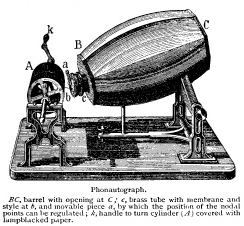Phonograph
(Redirected from Phonographic)
Phonograph
The phonograph, also known as a record player, is a device for the mechanical recording and reproduction of sound. In its later forms, it is also called a gramophone (as a trademark since 1887, as a generic name in the UK since 1910). The sound vibration waveforms are recorded as corresponding physical deviations of a spiral groove engraved, etched, incised, or impressed into the surface of a rotating cylinder or disc, called a "record". To recreate the sound, the surface is traced with a stylus or needle, which vibrates with the undulations of the groove, thereby reproducing the original sound waves. The phonograph was invented in 1877 by Thomas Edison, while other inventors, such as Emile Berliner, developed similar devices that could record and play back sound.
History[edit | edit source]
The development of the phonograph marked a significant milestone in the history of sound recording technology. Edison's initial invention was a device that could both record and reproduce sound, primarily on tinfoil sheets wrapped around a rotating cylinder. However, the tinfoil was not a practical recording medium for everyday use and wore out quickly. Over the years, the technology evolved, with the introduction of wax cylinders and finally flat discs, which became the standard medium for sound recording.
Emile Berliner introduced the gramophone in the late 1880s, which used flat discs instead of cylinders. These discs were easier to manufacture, store, and ship, leading to the widespread adoption of the disc format and the eventual decline of the cylinder format in the early 20th century.
Technology[edit | edit source]
The phonograph operates on a simple principle: a stylus follows the grooves of a record, vibrating as it encounters the undulations of the groove. These vibrations are then amplified and converted back into sound. Early phonographs used mechanical amplification through a large horn, while modern record players use electronic amplification to produce sound through speakers.
The quality of the sound produced by a phonograph depends on several factors, including the condition of the record and stylus, the accuracy of the stylus tracking the grooves, and the quality of the amplification system. Advances in technology have led to improvements in sound quality, with modern vinyl records and players offering high-fidelity sound reproduction.
Impact[edit | edit source]
The phonograph had a profound impact on society and culture. It made music and spoken word recordings accessible to the masses, changing the way people consumed music and entertainment. It also had significant implications for the music industry, enabling the mass production and distribution of music recordings.
The phonograph also played a crucial role in the preservation of cultural heritage, allowing for the recording and archiving of musical performances, speeches, and other significant audio events. Its invention marked the beginning of the era of recorded sound, which has continued to evolve with the development of digital recording and playback technologies.
See Also[edit | edit source]
Search WikiMD
Ad.Tired of being Overweight? Try W8MD's physician weight loss program.
Semaglutide (Ozempic / Wegovy and Tirzepatide (Mounjaro / Zepbound) available.
Advertise on WikiMD
|
WikiMD's Wellness Encyclopedia |
| Let Food Be Thy Medicine Medicine Thy Food - Hippocrates |
Translate this page: - East Asian
中文,
日本,
한국어,
South Asian
हिन्दी,
தமிழ்,
తెలుగు,
Urdu,
ಕನ್ನಡ,
Southeast Asian
Indonesian,
Vietnamese,
Thai,
မြန်မာဘာသာ,
বাংলা
European
español,
Deutsch,
français,
Greek,
português do Brasil,
polski,
română,
русский,
Nederlands,
norsk,
svenska,
suomi,
Italian
Middle Eastern & African
عربى,
Turkish,
Persian,
Hebrew,
Afrikaans,
isiZulu,
Kiswahili,
Other
Bulgarian,
Hungarian,
Czech,
Swedish,
മലയാളം,
मराठी,
ਪੰਜਾਬੀ,
ગુજરાતી,
Portuguese,
Ukrainian
Medical Disclaimer: WikiMD is not a substitute for professional medical advice. The information on WikiMD is provided as an information resource only, may be incorrect, outdated or misleading, and is not to be used or relied on for any diagnostic or treatment purposes. Please consult your health care provider before making any healthcare decisions or for guidance about a specific medical condition. WikiMD expressly disclaims responsibility, and shall have no liability, for any damages, loss, injury, or liability whatsoever suffered as a result of your reliance on the information contained in this site. By visiting this site you agree to the foregoing terms and conditions, which may from time to time be changed or supplemented by WikiMD. If you do not agree to the foregoing terms and conditions, you should not enter or use this site. See full disclaimer.
Credits:Most images are courtesy of Wikimedia commons, and templates, categories Wikipedia, licensed under CC BY SA or similar.
Contributors: Prab R. Tumpati, MD




